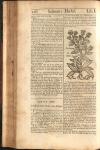
 I. The Names. It is called in Greek, ******* (but it is rather the name of Borage, for so the Greeks called that Plant, and this our Bugloss was rather the Lesser Bugloss; also ****** with Ddonaeus: which Parkinsin says was unknown to the Ancients. In Latin, Buglossum: and in Engish, Bugloss (after the Latin name.)
I. The Names. It is called in Greek, ******* (but it is rather the name of Borage, for so the Greeks called that Plant, and this our Bugloss was rather the Lesser Bugloss; also ****** with Ddonaeus: which Parkinsin says was unknown to the Ancients. In Latin, Buglossum: and in Engish, Bugloss (after the Latin name.)
II. The Kinds. There are several sorts of it, as,
- 1. The Garden, which is Buglossum Hortense.
- 2. Buglossa Sylvestris, Wild Bugloss.
- 3. Echium, Vipers Bugloss.
- 4. Wall and Stone Bugloss.
- 5. Limonium, Marsh Bugloss: Of these last four we shall treat in the four next Chapters.
- 6. Anchusa, Alkanet, of which we have treated in Chap. 8. aforegoing.
III. The Garden Kind, of which we treat in this Chapter, is twofold, viz.
- 1. ******, Lucopsis Buglossum Vulgare, which is the Greater Bugloss. (Anchusa italica? -Henriette.)
- 2. Buglossum Luteum, which is the Lesser Bugloss by some called Ox-Tongue, or Garden Ox-Tongue. (Picris echioides. -Henriette.)
 IV. The Description. Our Common Bugloss has a Root which is black without, and whitish within, long, thick, and full of a slimy Juice (as the Leaves also are) which continues and perishes not every Year, as the Root of Borage does; from this Root comes up several long, narrow, hairy, whitish green Leaves, among which rise up two or three very high Stalks, branched at the top, whereon stand many blew flowers, consisting of five small round pointed Leaves, with a small Pointel in the middle, which are very smooth, shining, and of a reddish purple, whilst they are Buds, and not blown open, which being fallen, there grows in the green Husks, in which the flowers stood, three or four roundish black Seeds, having that Thread or Pointel, standing still in the middle of them.
IV. The Description. Our Common Bugloss has a Root which is black without, and whitish within, long, thick, and full of a slimy Juice (as the Leaves also are) which continues and perishes not every Year, as the Root of Borage does; from this Root comes up several long, narrow, hairy, whitish green Leaves, among which rise up two or three very high Stalks, branched at the top, whereon stand many blew flowers, consisting of five small round pointed Leaves, with a small Pointel in the middle, which are very smooth, shining, and of a reddish purple, whilst they are Buds, and not blown open, which being fallen, there grows in the green Husks, in which the flowers stood, three or four roundish black Seeds, having that Thread or Pointel, standing still in the middle of them.
V. The Lesser Bugloss, which some will have to be Ox-tongue, is much lesser than the former, the Roots are long and creeping in the ground: and the Leaves are very rough, and rougher indeed than the former, like the rough Tongue of an Ox or Cow, (whence came the name) the Stalk is about two feet high, more or less, and commonly of a reddish color: at the top of the Branches grow the flowers in rough, scaly heads, which flowers are composed of many small yellow Leaves, much like those of Dandelion, and fly away in Down like as they do, these flowers are bitter of taste, whence Lobel calls it, Buglossum Echioides luteum Hieracio cognatum.
VI. The Places. The first is only Nursed up in Gardens, so also is the second: but this latter is found to grow wild in many places, as between Redriff and Deptford, by watry Ditch sides, as Gerard says.
VII. The Times. They flower in May, June, and July, to the end of Summer, and the Seed ripens in the mean Season.
VIII. As to their Qualities, Specification, Preparations, Virtues and Uses, they are altogether the same with those of Garden Borage, of which we have treated before in Chap. 83. to which you are referred. But this is to be noted in Bugloss, that its Roots are much more Mucilaginous, Viscous, or Clammy than those of Borage, and therefore are held not to be so convenient for opening Apozems: but the said Juice being made into a Lohoch or Licking Electuary, may be prevalent against the Cough, Hoarsess, and Colds, and to condensate thin Distillations of Flegm upon the Lungs.
Botanologia, or The English Herbal, was written by William Salmon, M.D., in 1710.
This chapter has been proofread by Nick Jones.

